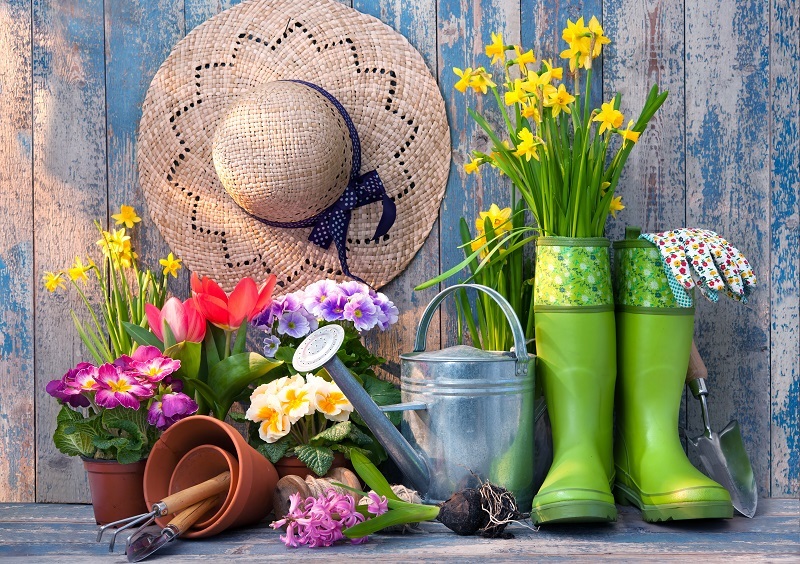Cultivating Lush Hydrangeas: A Step-by-Step Guide
Posted on 17/08/2025
Cultivating Lush Hydrangeas: A Step-by-Step Guide
Hydrangeas are renowned for their spectacular blooms and decorative appeal. Whether you're a seasoned gardener or a curious beginner, learning how to grow vibrant hydrangeas is both rewarding and straightforward. This comprehensive guide will walk you through every stage of cultivating lush hydrangeas--from selecting the ideal variety to maintaining their glory year after year.
Understanding Hydrangeas: An Introduction
Originating from Asia and the Americas, hydrangeas (family: Hydrangeaceae) have been popular garden fixtures for centuries. Their ample, globe-shaped blossoms come in spectacular shades of blue, pink, white, and purple--often changing color depending on the soil's pH levels.
Hydrangeas add instant charm to any landscape, whether grown as hedges, borders, or container plants. Yet, thriving hydrangea care demands some thoughtful consideration, making it vital to follow a correct cultivation process.

Step 1: Choosing the Right Hydrangea Variety
The first key to vibrant, healthy plants is selecting the perfect hydrangea type suited to your garden's location, climate, and aesthetic preference. Here are the most popular hydrangea species:
- Hydrangea macrophylla (Bigleaf Hydrangea): Famous for its large mophead and lacecap blooms, this variety is the most common in gardens. Flowers can change color based on soil acidity.
- Hydrangea paniculata (Panicle Hydrangea): Known for conical flower heads, this hardy type is perfect for colder climates.
- Hydrangea arborescens (Smooth Hydrangea): Produces ball-shaped white flowers; 'Annabelle' is a celebrated cultivar.
- Hydrangea quercifolia (Oakleaf Hydrangea): Named for its distinctive foliage, which turns bronze-purple in fall. This species thrives in partial shade.
- Hydrangea serrata: Similar to macrophylla but more cold-resistant; ideal for cooler gardens.
When choosing a hydrangea, consider winter hardiness, sunlight needs, and mature size to ensure your plant flourishes.
Step 2: Selecting the Perfect Planting Site
The next step towards lush blooms involves site selection. Hydrangeas thrive best in locations with:
- Morning sun and afternoon shade (especially in hot climates).
- Well-drained, fertile soil enriched with organic matter.
- Good air circulation but protection from strong afternoon winds.
Tip: Avoid planting hydrangeas under shallow-rooted trees or in low-lying areas prone to standing water.
Soil Preparation for Healthy Hydrangeas
Ideal hydrangea soil is slightly acidic to neutral (pH 5.5-6.5) and rich in humus. To prepare your planting site:
- Remove weeds and dig a hole twice as wide and just as deep as the root ball.
- Mix the native soil with compost, peat moss, or well-rotted manure to improve drainage and fertility.
- If your soil is especially clay-heavy, incorporate sand and organic matter for texture.
Step 3: Correct Planting Techniques for Hydrangeas
Spring or fall are the best times for planting hydrangeas. Follow these simple steps for optimal growth:
- Water thoroughly before planting to minimize shock.
- Loosen the roots gently if the plant is root-bound.
- Position the hydrangea so the top of the root ball is level with soil surface.
- Fill the hole and press the soil gently to remove air pockets.
- Water deeply after planting, ensuring the roots are well moistened.
- Apply a 2"-3" mulch layer to help retain soil moisture and suppress weeds.
Be sure not to bury the stem. Hydrangeas prefer the crown just at or slightly above soil level.
Step 4: Nurturing Lush Hydrangea Growth
Watering Hydrangeas Properly
One key to cultivating lush hydrangeas is consistent moisture, especially during the growing season:
- Water deeply once or twice a week, providing about 1 inch of water.
- In dry or sandy soils, increase watering frequency.
- To prevent disease, avoid wetting hydrangea leaves in the evening.
Fertilizing for Healthy Blooms
Hydrangeas have moderate feeding requirements. For robust flowering:
- Apply a slow-release, balanced fertilizer (10-10-10 or 14-14-14) in early spring.
- For Bigleaf hydrangeas, use a fertilizer formulated for acid-loving plants if you want to enhance blue coloration.
- Avoid excess nitrogen, as it encourages leaf growth at the expense of flowers.
Mulching Matters
Mulch conserves soil moisture, stabilizes root temperature, and keeps weeds at bay. Use shredded bark, straw, or compost, renewing the mulch layer each spring.
Step 5: Pruning Hydrangeas for Maximum Blooms
Proper pruning is crucial to cultivating lush hydrangea bushes. However, techniques vary by variety:
- Bigleaf & Oakleaf Hydrangeas: Bloom on old wood; prune immediately after flowering, removing spent blooms and weak stems.
- Panicle & Smooth Hydrangeas: Bloom on new wood; prune late winter or early spring, cutting back to 1/3 of the plant's size.
General tips for pruning hydrangeas:
- Remove damaged, dead, or crossing branches to improve air flow.
- Shape as needed, but avoid excessive trimming which can limit blooms.
- Disinfect pruning tools between plants to prevent disease spread.
Step 6: Controlling Pests & Diseases
While hydrangeas are generally tough, they can fall prey to pests and diseases. Staying alert and applying integrated pest management will ensure a lush hydrangea display.
Common Problems and Solutions for Hydrangeas
- Powdery mildew: Avoid overhead watering; increase air circulation by strategic pruning.
- Aphids, spider mites, scale: Wash off bugs with a hose or treat with insecticidal soap.
- Root rot: Improve drainage and avoid overwatering.
- Leaf spots: Remove affected leaves and avoid watering foliage.
If issues persist, opt for organic solutions whenever possible to protect your garden's ecosystem.
Step 7: Adjusting Hydrangea Flower Colors
One of the most exciting aspects of growing hydrangeas is the ability to change their flower colors (in most Bigleaf hydrangea varieties):
- Blue flowers: Maintain acidic soil (pH 5.2-5.5) by adding garden sulfur, peat moss, or aluminum sulfate.
- Pink flowers: Encourage alkaline soil (pH 6.0-6.2) by adding lime or wood ash.
White hydrangeas (such as 'Annabelle' and PeeGee hydrangea) remain white regardless of soil pH.
Step 8: Winter Protection for Hydrangeas
In cold regions, safeguarding your hydrangeas ensures a healthy comeback in spring:
- Mulch generously around plant bases to insulate roots.
- For potted hydrangeas: Move containers to sheltered areas or bury pots in the ground.
- Wrap exposed branches with burlap or frost cloth for added protection.
Newly planted hydrangeas are especially vulnerable to winter damage, so take extra care during their first year.
Hydrangea Care Tips for Every Season
Spring Hydrangea Care
- Uncover mulched plants and prune if needed.
- Apply fertilizer as growth resumes.
- Watch for emerging pests or disease signs.
Summer Hydrangea Care
- Water deeply during dry spells.
- Deadhead faded blooms for ongoing beauty.
- Mulch to conserve water and cool roots.
Fall Hydrangea Care
- Prune selectively, only for species that require it.
- Do not fertilize late in the season, as it can delay plant dormancy.
- Add an extra mulch layer before the ground freezes.
Winter Hydrangea Care
- Check mulched plants after storms, reapplying mulch if necessary.
- Wrap and protect as needed in harsh weather areas.
Hydrangea Propagation: How to Multiply Your Lush Blooms
Would you love more luscious hydrangeas in your garden or to share with friends? Propagation is easy:
- Cuttings: Snip a 6" healthy stem in early summer. Remove lower leaves and root in moist potting soil; keep in bright, indirect light until established.
- Division: Early spring or late fall, dig up mature hydrangeas and gently divide root sections for replanting.
- Layering: Bend a low-growing branch to the ground, cover with soil, and wait for roots to form before severing and transplanting.
Creating Stunning Garden Designs with Hydrangeas
Lush hydrangeas aren't just garden stars on their own--they offer remarkable pairing possibilities:
- Pair hydrangeas with evergreens for year-round structure.
- Combine with ferns, hostas, and hellebores in shaded mixed borders.
- Create jaw-dropping mass plantings along driveways or property lines.
- Grow in large containers for patio and balcony color.
Experiment with different varieties to find the best combination for your space and climate.

Frequently Asked Questions About Lush Hydrangeas
Why are my hydrangeas not blooming?
Common causes include:
- Pruning at the wrong time (removing flower buds).
- Insufficient sunlight or improper feeding.
- Winter bud damage; protect your plants as needed.
Can hydrangeas grow in pots?
Absolutely! Choose compact varieties such as 'Cityline' or 'Little Lime Hydrangea.' Use large containers with excellent drainage and water often, as potted hydrangeas dry out faster.
How do I revive a wilting hydrangea?
Hydrangeas are thirsty plants. Water deeply and mulch generously in hot weather. If wilting persists, check for root rot or pest issues.
Conclusion: The Joy of Growing Lush Hydrangeas
By following this step-by-step guide to lush hydrangea cultivation, you'll unlock the secrets to stunning, healthy blooms that make your garden the envy of the neighborhood. Whether choosing vibrant varieties, nurturing their needs, or experimenting with flower colors, hydrangea gardening is truly rewarding. Enjoy a magnificent display year after year with these essential care steps and gardening insights.
Happy growing!







